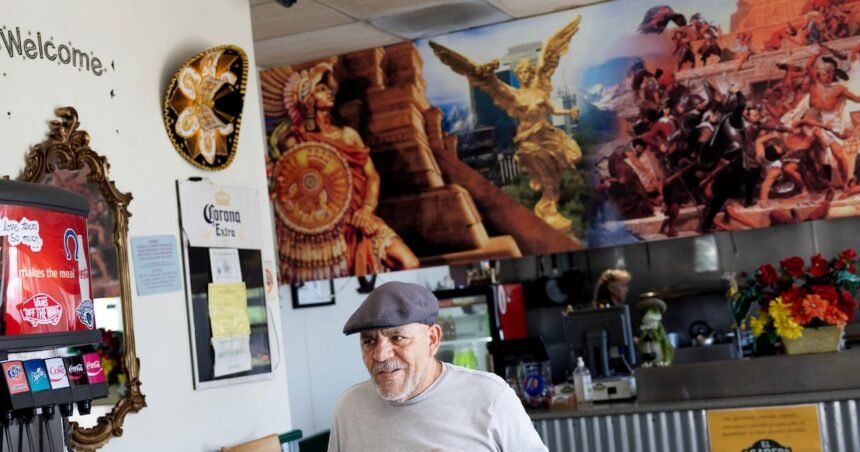A few blocks east of Margarito Parra’s Mexican restaurant, a giant mural contains a defiant message amid worries of some about gentrification in Salt Lake City’s west side: “This neighborhood isn’t for sale.”
Growth and development is surging around him, however, and Parra is learning first hand that sometimes those forces won’t be denied, that money, in fact, is a driving force, notwithstanding the message on the mural at North Temple and 700 West. The operator of El Asadero since 2009, he has decried gentrification in the west side but will close his eatery at the end of July, prodded, in part, by plans to redevelop the site where his business sits.
“He has other plans for this space,” said Parra, alluding to Jereme Thaxton, the principal behind Alta Bay Capital and varied development firms pursuing a number of apartment projects on Salt Lake City’s west side.
He doesn’t begrudge Thaxton, who had offered him one of the commercial spots on the ground floor of an Alta Bay apartment building taking shape adjacent to the El Asadero site at 1011 W. North Temple. The cost of retrofitting the spot, some $200,000, was more than Parra, an immigrant from Mexico, could afford, though Thaxton had also offered discounted rent. What’s more, Parra and wife Imelda Morales want to slow down and retire after a roller-coaster ride operating the business in recent years as the neighborhood has morphed with new, high-density development.

Still, Parra notes with chagrin the pressures reshaping the west side, sometimes at the expense of those who have lived and thrived in the area, historically a working-class enclave. The North Temple and 700 West mural, which reads, in Spanish, “Este barrio no se vende,” was inspired by such laments as developers buy up the land, while Parra’s journey is a microcosm of the forces at play.
“It’s money, power, the government,” he said. “History says they always win.”
Indeed, the area around El Asadero, which sits in the shadow of the seven-story apartment building Alta Bay acquired last year, has shifted dramatically from what it once was, according to Parra, himself a west-side resident. Single-family homes once occupied the land around the business, and he had a regular cadre of customers he knew personally, making for a bustling, cohesive neighborhood.
“I knew all of the neighbors, and they knew me,” he said.

Now, with many of the homes torn down to make way for apartment buildings, some of them still works in progress, the tone is different. “When it’s apartments, no one talks. The communication is lost. This is happening, and it’s what’s going to happen,” he said.
Aside from the apartment building to the immediate west of El Asadero, still vacant, a five-story apartment building is being built across 1000 West to the east, where single-family homes once stood. Chicago Street and Emeril Avenues east of 1000 West are similarly being transformed with high-density housing proposals, displacing, at times, longtime homeowners. Significantly, city leaders and boosters have been mulling development of a baseball stadium in the neighborhood as part of their efforts to draw a Major League Baseball team to Salt Lake City, further transforming the area.
Preserving the west-side character
Thaxton, for his part, laments the departure of Parra and El Asadero. Alta Capital’s acquisition of the apartment building west of El Asadero and the El Asadero site itself had forestalled the earlier closure of the restaurant, which had been feeling pressure to leave under the prior landowners. In fact, Thaxton has tried to come up with a plan enabling Parra to remain.
“We are truly disappointed that we have not yet been able to find a path that allows them to remain in the area, and we feel El Asadero would have provided not only an amenity to nearby residents but also a significant benefit to the surrounding community,” Thaxton said in an email. “Alta Bay’s mission is (to) build the future of housing by creating vibrant communities that improve the lives of our residents, and we feel keeping El Asadero in place is in line with this mission.”

The plans for the parcel where El Asadero now sits call for mixed-use commercial and residential development, with the housing to be earmarked for lower-income people, those earning 50%-60% of the area median income. “We also intend to activate the street frontage with ground-level commercial space for local businesses to operate and thrive, which may include day care, restaurants and live/work units,” Thaxton said.
Thaxton is mindful of the laments about gentrification and criticism of some that longtime residents are being forced out of west-side neighborhoods like Poplar Grove, Fairpark and Rose Park.
His team has been working with city leaders “to determine ways that we, as developers, can help preserve the character of the west side and to facilitate avenues for affordable housing for both longtime residents of the area and new residents alike,” he said. Moreover, the developer’s “people-centered” design, he noted, aims to create vibrant communities and affordable housing options as home prices and rent spike.
Regardless, for Parra, the plans to shut the restaurant’s doors on July 31 aren’t all about the new forces molding the west side. The lure of retirement is strong, notwithstanding the melancholy that comes with shifting gears, and he’s grateful for the support the business has received over the years. “I’m going to miss all the people who came,” he said.











